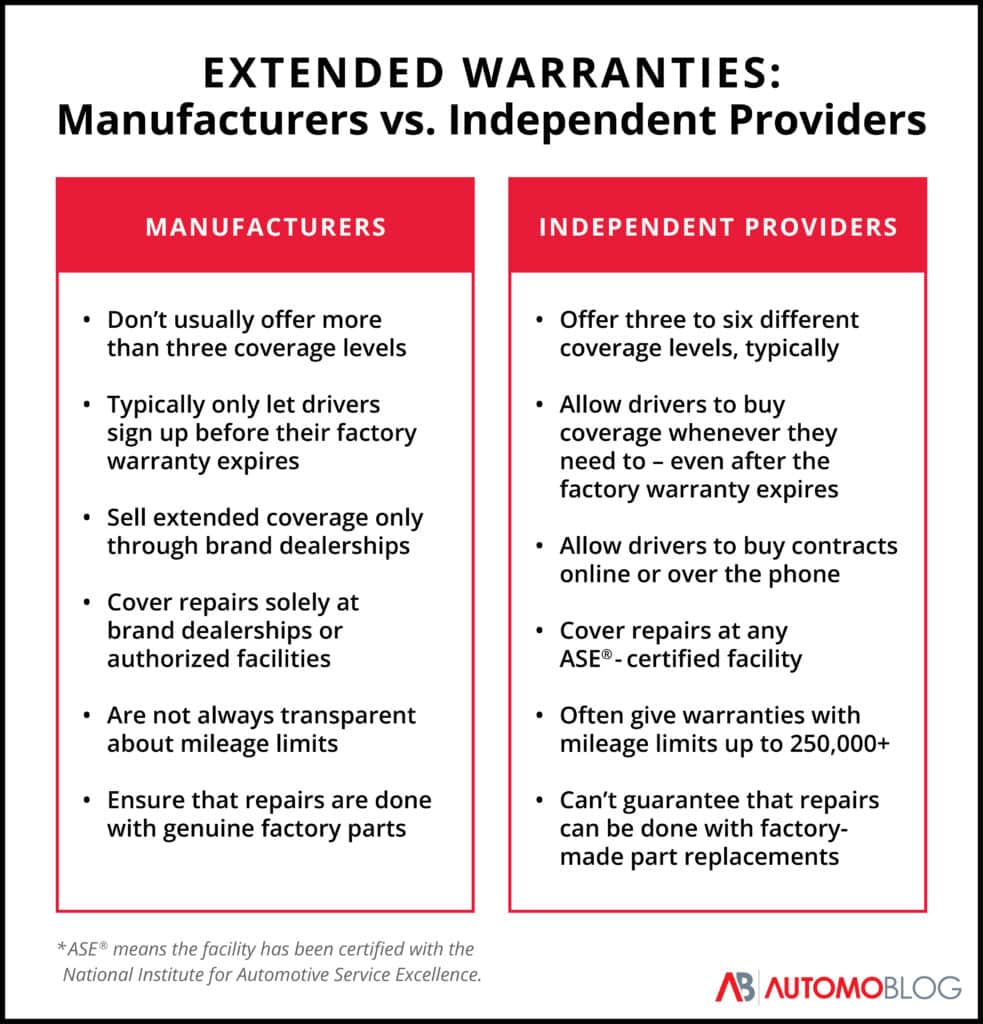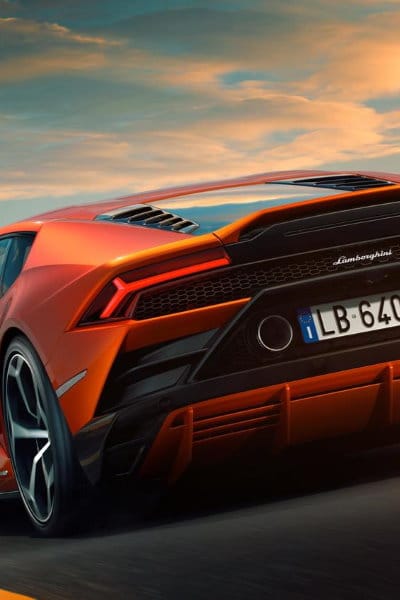Affiliate Disclosure: Automoblog and its partners may earn a commission if you purchase coverage from the extended warranty providers outlined here. These commissions come to us at no additional cost to you. Our research team has carefully vetted dozens of extended warranty providers. See our Privacy Policy to learn more.
Crash Course:
- New cars come with bumper-to-bumper coverage as part of the factory warranty. Hyundai and Kia offer the longest coverage terms.
- You can extend your factory vehicle warranty by purchasing extended coverage, from either the manufacturer or a third-party provider.
- Aftermarket warranty providers tend to offer more flexibility, benefits, and options than manufacturers.
Bumper-to-bumper warranty plans are the highest level of coverage available from any manufacturer or third-party extended warranty provider. These plans cover the cost of car repairs on almost every component in a vehicle.
In this review, we share all you need to know about bumper-to-bumper warranties, including what they cover, what they don’t, and terms offered by select manufacturers through their factory coverage. You’ll also learn how to continue your bumper-to-bumper warranty after your factory coverage expires, along with recommendations for a few of the best extended car warranty companies in the industry.
What Is a Bumper-To-Bumper Warranty?
A bumper-to-bumper warranty, also known as an exclusionary warranty, offers the highest level of protection for vehicles and covers almost any mechanical breakdown caused by defective parts and workmanship.
All new vehicles come with bumper-to-bumper coverage through the manufacturer’s new vehicle limited warranty. These plans typically last about three years or 36,000 miles, whichever comes first. Bumper-to-bumper contracts are exclusionary, meaning they have a short list of the parts they don’t cover, rather than the parts they do.
Bumper-To-Bumper vs. Powertrain
New vehicle limited warranties bundle bumper-to-bumper warranties and powertrain warranties together to protect the vehicle. And while these two plans go hand in hand, they cover different parts, often creating confusion.
Here’s a look at the differences between the two warranties:
- Bumper-to-bumper warranty: This offers comprehensive, high-level coverage to protect your vehicle’s most important components. It typically lasts for 3 years/36,000 miles.
- Powertrain warranty: A powertrain warranty covers your vehicle’s most essential components, including the engine, transmission, and drive axle. Powertrain coverage normally lasts longer than a bumper-to-bumper warranty, usually five years or 60,000 miles at a minimum.
What Does a Bumper-To-Bumper Warranty Cover?
Bumper-to-bumper plans are the most comprehensive warranties available, both for factory warranties and extended vehicle service contracts. They’re called “bumper-to-bumper” because they cover repairs to almost every part of a vehicle between its front and rear bumpers.
Components and systems typically covered under a bumper-to-bumper coverage plan include:
- Audio, communication, and entertainment systems
- Air conditioning and heating
- Electronics and electrical systems (power seats, sunroofs, etc.)
- Engine, transmission, and drive axles
- Steering and braking systems
- Suspension
- Vehicle body
- Fuel delivery
What Does a Bumper-To-Bumper Warranty Not Cover?
Bumper-to-bumper warranties are sometimes called “exclusionary” warranties because not all car parts are protected. Each contract includes a list of items not covered under warranty, known as exclusions. These exclusions are typically listed in the fine print of a warranty contract.
Bumper-to-Bumper Warranty Exclusions
The list of exclusions may vary slightly between automakers and providers. However, the items not covered under a bumper-to-bumper protection plan are generally similar. The most common exclusions include:
- Automotive glass such as brake lights, headlights, turn signals, windows, and windshields
- Wear items such as brake pads, brake rotors, tires, upholstery, seat belts, windshield wiper blades, and paint
- Routine maintenance services such as oil changes, wheel alignments, and tire rotations
- Damage from corrosion
- Damage from collisions
- Damage from misuse, such as racing or overloading your vehicle
- Damage from theft, vandalism, or other sources covered by comprehensive car insurance policies
How Long Does a Bumper-To-Bumper Warranty Last?
Bumper-to-bumper warranty terms typically last three years or 36,000 miles, whichever comes first. However, some manufacturers include longer coverage terms with new vehicles.
The table below provides details for new vehicle limited warranties from several popular auto brands.
| Manufacturer | Bumper-To-Bumper Warranty Length | Powertrain Warranty Length | Roadside Assistance |
|---|---|---|---|
| Chevrolet | 3 years/36,000 miles | 5 years/60,000 miles | Yes |
| Ford | 3 years/36,000 miles | 5 years/60,000 miles | Yes |
| Honda | 3 years/36,000 miles | 5 years/60,000 miles | Yes |
| Nissan | 3 years/36,000 miles | 5 years/60,000 miles | Yes |
| Hyundai | 5 years/60,000 miles | 10 years/100,000 miles | Yes |
| Kia | 5 years/60,000 miles | 10 years/100,000 miles | Yes |
Bumper-To-Bumper Extended Warranty
No matter how long the manufacturer’s warranty terms are, your factory coverage will expire at some point. When it does, you’ll have to foot the bill for mechanical repairs unless you decide to extend your coverage. You can do this by purchasing a bumper-to-bumper extended warranty.
Bumper-to-Bumper Extended Warranty Cost
The average cost of a bumper-to-bumper extended warranty is around $2,500 in total. However, prices vary widely. In our secret shopper study, we received quotes for bumper-to-bumper warranties ranging from $1,700 to $4,600 for three to seven years of coverage.
Extended Bumper-To-Bumper Warranty Cost Factors
Bumper-to-bumper extended warranty costs are based on several factors, including the following:
- Your location
- The type of car you drive
- The deductible you choose
- Your vehicle’s age, mileage, and condition
- Your warranty provider
Bumper-To-Bumper Warranty Quotes
We reached out to Endurance, CARCHEX, and CarShield for bumper-to-bumper coverage quotes for a 2019 Toyota Camry with 28,000 miles. These were the prices we received:
| Warranty Factors | Endurance | CARCHEX | CarShield |
|---|---|---|---|
| Plan | Supreme | Titanium | Diamond |
| Term Length | 5 years/100,000 miles | Unlimited | Unlimited |
| Deductible | $100.00 | $100.00 | $100.00 |
| Monthly Price | $146.50 | $139.99 | $139.99 |
| Total Cost | $1,758 | Varies | Varies |
Where To Buy a Bumper-To-Bumper Warranty
If you choose to extend your coverage, you have options. Many manufacturers offer branded warranties that you can purchase through the dealership. You can also purchase a bumper-to-bumper vehicle protection plan from a third-party warranty provider.
Manufacturer vs. Aftermarket Bumper-To-Bumper Warranties
The main advantage of a manufacturer’s extended warranty is that repairs will be done by brand-certified technicians using approved replacement parts at the dealership. This can be comforting to people who trust their automaker or dealership.
However, this can also be a limitation. By contrast, aftermarket bumper-to-bumper plans typically allow you to choose where you have repairs done. That means you don’t have to wait for an appointment at the dealership and can go to a neighborhood mechanic that you prefer.
You also have more flexibility in how and when you can buy an extended warranty from a third-party provider. Most automakers require you to purchase additional coverage before your factory warranty expires. You can purchase extended coverage from an aftermarket provider at almost any time. Plus, most offer plans for cars with more than 100,000 miles on the odometer.
Bumper-To-Bumper Extended Warranty Benefits
Most manufacturer and third-party bumper-to-bumper extended warranty plans come with additional perks. These include:
- 24/7 roadside assistance: Provides services such as lockouts, battery jump-starts, emergency fuel deliveries, and more
- Courtesy towing: Coverage for towing to the nearest dealership, or if you have a third-party warranty, the certified repair facility of your choice
- Trip interruption coverage: Reimbursement for meals and lodging if your vehicle breaks down far from your home and you have to stay overnight while it’s being repaired
- Rental car reimbursement: Coverage for alternative transportation while your vehicle is at the repair shop for a covered service
Exact coverage details and added perks vary depending on the provider you choose.

Is a Bumper-To-Bumper Extended Warranty Worth It?
Bumper-to-bumper extended warranties offer value to car owners in several ways. If your car does need mechanical repairs, the cost of those repairs could easily surpass the cost of the warranty.
But even if you don’t get back more than you invested, extended warranties can help make finances more predictable. They allow you to avoid the risk of expensive repair bills that could be thousands of dollars. That makes warranties a good option for people who may not be able to cover those expenses out of pocket.
Bumper-To-Bumper Warranty: Conclusion
Most new vehicles come with a bumper-to-bumper warranty. Manufacturers, dealerships, and third-party providers offer extended bumper-to-bumper extended warranties that can be great for drivers who want additional coverage after their factory warranty expires. Third-party provider plans tend to be more affordable and allow you to choose your own repair shop compared with manufacturers and dealerships.
We recommend you look at each provider’s sample contracts and compare quotes from at least three extended auto warranty providers.
Best Bumper-To-Bumper Warranty
As part of our 2024 auto warranty study, we identified a few of our top choices for bumper-to-bumper extended warranties. You’ll find those providers in the section below.
#1 Endurance Supreme Warranty
The Endurance Supreme bumper-to-bumper extended warranty is best for drivers who want:
- Comprehensive coverage
- Low monthly financing terms
- Helpful customer service representatives
- The most extensive perks offered by any reputable extended car warranty company
The Supreme plan covers all major vehicle parts and has standard exclusions. All Endurance plans come with roadside assistance, rental car coverage, and trip interruption coverage for the duration of your warranty, The provider also includes a free year of enrollment into the Endurance Elite Benefits program with every plan. This provides extra benefits such as:
- Additional roadside assistance
- Key fob and tire repairs or replacements
- Up to $1,000 toward a replacement vehicle in total loss protection
- Collision discount of up to $500 per covered collision with a $1,000 limit
Learn more about coverage in our complete Endurance warranty review.
#2 CARCHEX Titanium Coverage
CARCHEX may be the best choice for drivers who want a provider that:
- Has thousands of positive customer reviews online
- Offers coverage terms up to 10 years or 250,000 miles
- Partners with major auto industry experts like Kelley Blue Book and CARFAX
The CARCHEX Titanium plan is an exclusionary extended warranty that is similar to a bumper-to-bumper warranty. It comes with perks including roadside assistance, towing services, rental car reimbursement, and trip interruption coverage.
CARCHEX has a positive reputation among both industry experts and customers. It currently holds an A+ rating from the Better Business Bureau (BBB), which indicates that it uses sound business practices and handles customer complaints effectively.
To learn more about the warranty coverage that CARCHEX provides, check out our full CARCHEX review.
#3 CarShield Diamond Coverage
CarShield has the most budget-friendly aftermarket car warranty in the industry. This provider is a great choice for drivers who want:
- Affordable pricing
- Flexible financing options
- Coverage for alternative vehicles like motorcycles
CarShield’s Diamond plan provides bumper-to-bumper coverage for vehicles up to 300,000 miles. All plans come with standard benefits including emergency roadside assistance, rental car reimbursement, and trip interruption coverage.
This provider has been in business for almost 20 years and offers six coverage plans. It’s one of the only top providers to cover motorcycles and ATVs as well as standard automobiles.
Read our comprehensive CarShield review to find out more about this provider.
Bumper-To-Bumper Warranties: FAQ
Below are frequently asked questions about bumper-to-bumper warranties:
What does a bumper-to-bumper warranty cover?
A bumper-to-bumper warranty covers the most essential vehicle components after a mechanical breakdown. Items that are typically covered include the powertrain (engine, transmission, and drive axle), fuel system, steer system, braking system, electrical parts, and safety equipment.
How many miles is a bumper-to-bumper warranty?
Most bumper-to-bumper warranty coverage lasts three years or 36,000 miles, whichever comes first. After the new factory warranty expires, you can still purchase a bumper-to-bumper extended warranty or vehicle service contract from a third-party provider.
What’s the difference between a powertrain warranty and a bumper-to-bumper warranty?
Powertrain warranties only cover only your vehicle’s most vital components like the engine, transmission, and drivetrain. Bumper-to-bumper warranties cover almost every car part, including those covered by powertrain plans.
Are bumper-to-bumper extended warranty plans worth it?
Bumper-to-bumper extended warranty plans are worth it for many drivers. Even if you’re confident in your car’s reliability, a bumper-to-bumper extended warranty could still give you added peace of mind on the road with coverage for most car parts after mechanical breakdowns.
Are bumper-to-bumper extended warranty prices negotiable?
Bumper-to-bumper extended warranty prices may be negotiable depending on where you purchase coverage from. No matter where you purchase your coverage, it’s worth at least trying to talk down the price of your bumper-to-bumper extended warranty.
Our Methodology
Our expert review team takes satisfaction in providing accurate and unbiased information. We identified the following rating categories based on consumer survey data and conducted extensive research to formulate rankings of the best extended auto warranty providers.
- Industry Standing: Our team considers Better Business Bureau (BBB) ratings, availability, and years in business when giving this score.
- Coverage: Because each consumer has unique needs, it’s essential that a car warranty company offers an array of coverage options. We take into account the number of plans offered by each provider, term limits, exclusions, and additional benefits.
- Affordability: A variety of factors influence cost, so it can be difficult to compare quotes between providers. Our team performs ongoing secret shopper analyses for different vehicles, mileages, warranty plans, and locations to give this rating.
- Transparency: We consider the transparency of each company’s contracts and the availability of a money-back guarantee when determining this score.
- Customer Service: Reputable extended car warranty companies operate with a certain degree of care for consumers. We take into account customer reviews, BBB complaints, and the responsiveness of the customer service team.
*Data accurate at time of publication.



